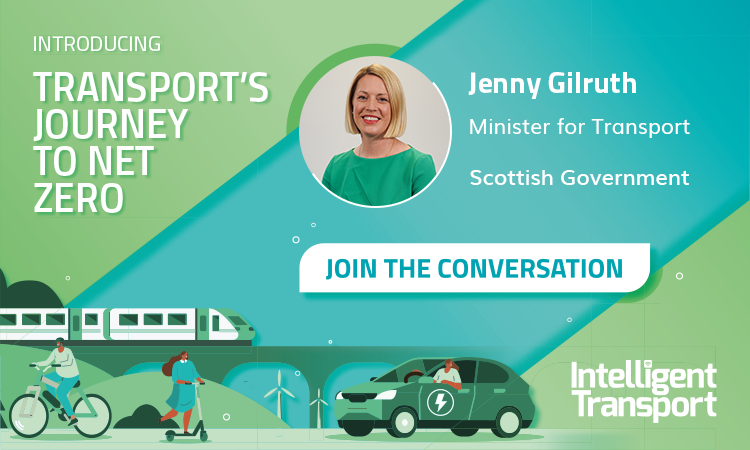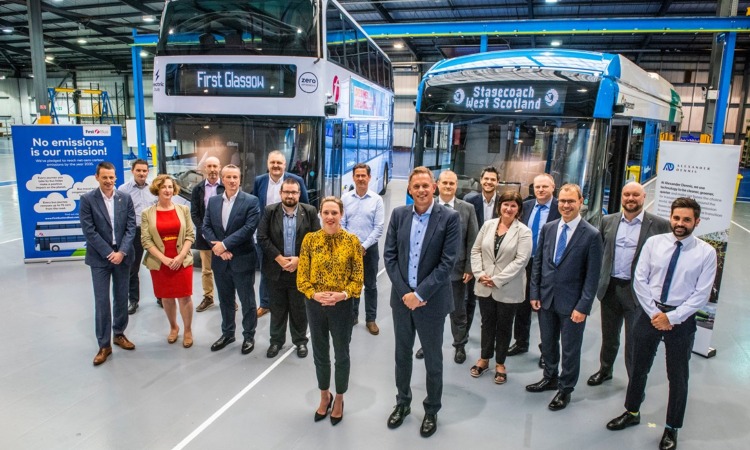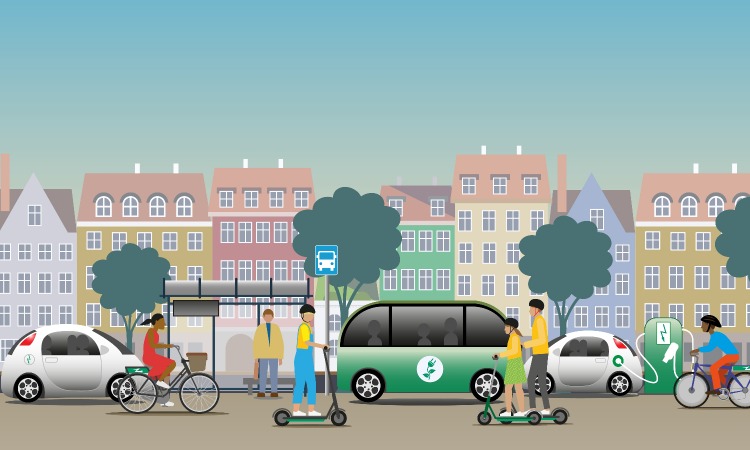Transport’s journey to net zero: Affordable public transport is vital to foster sustainable travel habits, says Scotland’s Transport Minister
- Like
- Digg
- Del
- Tumblr
- VKontakte
- Buffer
- Love This
- Odnoklassniki
- Meneame
- Blogger
- Amazon
- Yahoo Mail
- Gmail
- AOL
- Newsvine
- HackerNews
- Evernote
- MySpace
- Mail.ru
- Viadeo
- Line
- Comments
- Yummly
- SMS
- Viber
- Telegram
- Subscribe
- Skype
- Facebook Messenger
- Kakao
- LiveJournal
- Yammer
- Edgar
- Fintel
- Mix
- Instapaper
- Copy Link
Posted: 2 December 2022 | Jenny Gilruth - Scottish Government | No comments yet
In the latest instalment of Intelligent Transport’s exclusive sustainable mobility Q&A series, Jenny Gilruth MSP, Scotland’s Minister for Transport, discusses the work that the country is currently undertaking to decarbonise its transport sector, make public transport more accessible and improve active travel infrastructure, as well as why an independent Scotland may be the key to accelerating the nation’s transition to a net zero future.


The ever-pressing challenges of poor air quality and traffic congestion have been a key focus for the transport industry, as operators and authorities strive to achieve their net zero targets. How big a part does the decarbonisation of public transport play in reducing Scotland’s carbon emissions?
Decarbonisation is absolutely critical, and we are extremely committed to making it happen through our ‘Mission Zero’ programme, which focuses on decarbonising the transport sector at pace”
We’ve looked closely at what is required within the transport sector to meet Scotland’s target of net zero by 2045. Decarbonisation is absolutely critical, and we are extremely committed to making it happen through our ‘Mission Zero’ programme, which focuses on decarbonising the transport sector at pace. This includes £120 million to support the roll-out of fully electric battery and hydrogen buses – many of which will be built in Scotland, supporting skilled green jobs and growing green manufacturing. In addition, to make bus travel faster and more appealing, we’ve committed to investing over half a billion pounds in long-term funding for bus priority infrastructure, reducing the impact of congestion on our bus services.
Rail services will also be fully decarbonised in Scotland by 2035, with around 76 per cent of all passenger journeys and 45 per cent of freight services in Scotland already being made on electric services, and work continuing at pace to develop the forward programme of electrification, as is set out in the Rail Passenger Services Decarbonisation Action Plan.
Collectively, this work is accelerating the necessary transformation away from cars, with our world leading commitment to reduce car kilometres travelled by 20 per cent by 2030, towards sustainable, accessible and affordable public transport and our decarbonised transport future.
What are the immediate challenges that Transport Scotland is facing in decarbonising its public transport fleet?
Alongside supply chain issues, following Brexit, we have also lost people, skills and the ease with which we used to import and export”
Our targets are rightly ambitious to ensure that vital progress is made across the Scottish transport sector, and some, like removing the majority of diesel buses by the end of 2023, cannot be met by us alone – that’s why the work of our Bus Decarbonisation Taskforce has been critical to our success so far. We were right to aim high and to ensure progress across the sector – driving ambitions into delivery, with the proportion of zero-emission buses in Scotland now approximately three times higher than that in England.
However, challenges remain. The impact of Brexit – a hard Brexit, which Scotland rejected – was imposed during a global pandemic, and that cannot be understated. Alongside supply chain issues, following Brexit, we have also lost people, skills and the ease with which we used to import and export. Fundamentally, we face both the financial constraints of Westminster, which prevent us from doing everything that we’d like to at the pace that we would like to, and the timescale set by the UK government to ban fossil fuel vehicles, which we have repeatedly urged to be more ambitious.


Credit: Transport Scotland – Scotland’s Bus Decarbonisation Taskforce
What projects does Transport Scotland currently have in the pipeline that will help to achieve a more sustainable transport system in Scotland?
Free bus travel improves life chances, offers access to new opportunities and makes things easier during the cost-of-living crisis we’re now experiencing globally”
Three quarters of all public transport journeys here in Scotland are made by bus. We invest £300 million annually to provide free bus travel for over two million people – up to 50 per cent of the population – including all children and young people under 22, disabled people and everyone over 60. The expansion of free bus travel to under 22s is absolutely transformative, responding to the fact that our young people have been some of the most disproportionately impacted as a result of the pandemic. Free bus travel improves life chances, offers access to new opportunities and makes things easier during the cost-of-living crisis we’re now experiencing globally. With over 26 million journeys having been made since the scheme launched in January 2021, I’m confident that it will help our younger generations to reconnect with buses from an early age and encourage sustainable travel behaviours that they will then carry with them.
Of course, to make our buses even more attractive, they need to be quick to get you from A to B, unshackled from the impacts of congestion. If we support local authorities to build the infrastructure to support our buses, we can encourage a shift away from cars and towards sustainable public transport. That is why we have committed to providing over half a billion pounds in long-term funding for bus priority infrastructure.
Furthermore, on rail, we have built on our investment of £1 billion in the last 10 years to electrify 441km of track. We continue to reconnect communities to the rail network through reversal of the ‘Beeching’ cuts, helping thousands of people to choose to travel more sustainably, and offer price incentives through ScotRail. We also move more freight from road to rail, with 58 million lorry miles saved in the last year and over 40 per cent of our rail freight electrically hauled from origin to destination.
In addition, 2022’s Programme for Government commits to test a new mobility and scrappage scheme to support low-income households to replace a polluting vehicle with the means to travel sustainably.
Although public transport has seen a global increase in ridership post-pandemic, car use continues to be more resilient. What is being done to encourage modal shift from the private car, and how significant is improving active travel and public transport infrastructure in achieving this?
Cars account for nearly 40 per cent of transport emissions, and evidence is clear that we need to reduce overall car use, alongside a switch to cleaner vehicles, to meet our statutory emissions targets. So, we are absolutely committed to finding ways to make sustainable travel modes more attractive and supporting people to take fewer journeys by car, and improving active travel and public transport infrastructure is key to this. It will also involve reducing people’s need to travel with more local access to goods and services, digital connectivity and flexible and remote working approaches.
We don’t expect car use to reduce equally for all; yet, for those who are able to change their travel behaviour, we want to recognise and enable that”
Our route map to a 20 per cent reduction in car kilometres outlines what we are doing to support people to change their travel behaviour – changes that are good for people’s pockets, and for the planet. We understand that there is no ‘one size fits all’ approach, but we believe that the route map contains a range of options for everyone to consider. We don’t expect car use to reduce equally for all; yet, for those who are able to change their travel behaviour, we want to recognise and enable that. But there are limits to how much we can incentivise people to do things. There comes a point where other measures are needed, given the urgency and scale of change required, and that may mean looking at measures to discourage unnecessary car travel. Therefore, we need to take an evidence-based approach to what might work to achieve change, including learning from what others are doing across the UK and in other countries, too.
What are the biggest barriers to encouraging active travel in Scotland?
We’re focused on building an active nation where more people can walk, wheel and cycle for everyday shorter journeys. In August 2021, the Scottish government and the Scottish Green Party Parliamentary Group agreed to work together over the next five years to build a green economic recovery from COVID-19, respond to the climate emergency and create a fairer country. Through that agreement, we had committed to undertake a Fair Fares review to ensure a sustainable and integrated approach to transport fares.
My colleague Patrick Harvie MSP has joined the Scottish government as the first-ever Minister for Active Travel, with the agreement that funding for walking, wheeling and cycling would rise to £320 million or 10 per cent of the overall transport budget by 2024/25. This funding has the potential to transform our towns and cities, responding to barriers that we know exist around cycling safety, access to bikes, storage and amenities – as well as issues around inclusivity. The amount of overall funding is, of course, important – with many stakeholders calling for this level of investment for some time. How we spend the money, however, is vital – and I know that the Minister for Active Travel is working hard with partners to ensure that this money is being spent in the right way and in support of our wider 20 per cent car kilometre reduction route map – which acts as our guiding star, alongside our National Transport Strategy.
How big a contribution must Transport Scotland make in order for Scotland to meet its climate goals?
With around a third of Scotland’s emissions coming from the transport sector – we have a significant amount of work to undertake”
With around a third of Scotland’s emissions coming from the transport sector – we have a significant amount of work to undertake. This being said, we have the research, so we know what must be achieved and by when. Our focus is on continuing our work at pace to respond to the global climate emergency and deliver on our Mission Zero for transport. Decarbonising transport is a global challenge that we cannot solve alone. Our international engagement gives us access to global expertise, while showcasing our own skills and experience to new markets and potential investors. We continue to work with the Transport Decarbonisation Alliance, the Zero Emission Vehicle Community and others to influence global policy on transport and build partnerships to support practical action to deliver our shared ambitions.


In an ideal world, what would a net zero transport system look like to you?
First and foremost, a decarbonised, net zero transport system must serve the needs of everyone who uses it. That means it has to be affordable and accessible to all, in every part of Scotland. Ultimately, we do need people to travel less, so our communities will continue to be built around 20-minute design principles. Remote and flexible working will continue, with workforces more distributed than ever before.
Given full control… I truly believe that we can make a just transition, where no one is left behind and where we unlock economic opportunities across Scotland”
Furthermore, walking, wheeling or cycling to either the end destination or a public transport hub will feel like a safe and attractive option, knowing that we are all contributing to the ambitious – and essential – climate targets that we have set. More services will come straight to people or to their local neighbourhoods. Goods will be transported on a low-carbon freight system.
Above all, and I don’t think that it will come as a surprise when I say this, this system would operate in an independent Scotland. So many powers, levers and resources rest at Westminster and, given full control of all of these, I truly believe that we can make a just transition, where no one is left behind and where we unlock economic opportunities across Scotland as part of this essential response to the climate emergency.


Jenny was elected to represent the Mid Fife and Glenrothes Constituency at the 2016 election. She was previously the Minister for Europe and International Development and Minister for Culture, Europe and International Development, and was appointed as Scotland’s Minister for Transport in January 2022.
If you would like to take part in our ‘Transport’s journey to net zero’ series, or would like to nominate a colleague to take part, please email: Halimah Haque, Editorial Assistant, Intelligent Transport.
Related topics
Accessibility, Air Quality, Alternative Power, COVID-19, Infrastructure & Urban Planning, Mobility Services, Passenger Accessibility, Passenger Experience, Public Transport, Sustainable Urban Transport, Ticketing & Payments, Transport Governance & Policy, Transport’s Journey to Net Zero Series
Related modes
Bikes & Scooters, Bus & Coach, Rail, Walking
Related countries
Scotland, United Kingdom
Related organisations
Scottish Government, Transport Scotland, UK Government
Related people
Jenny Gilruth








